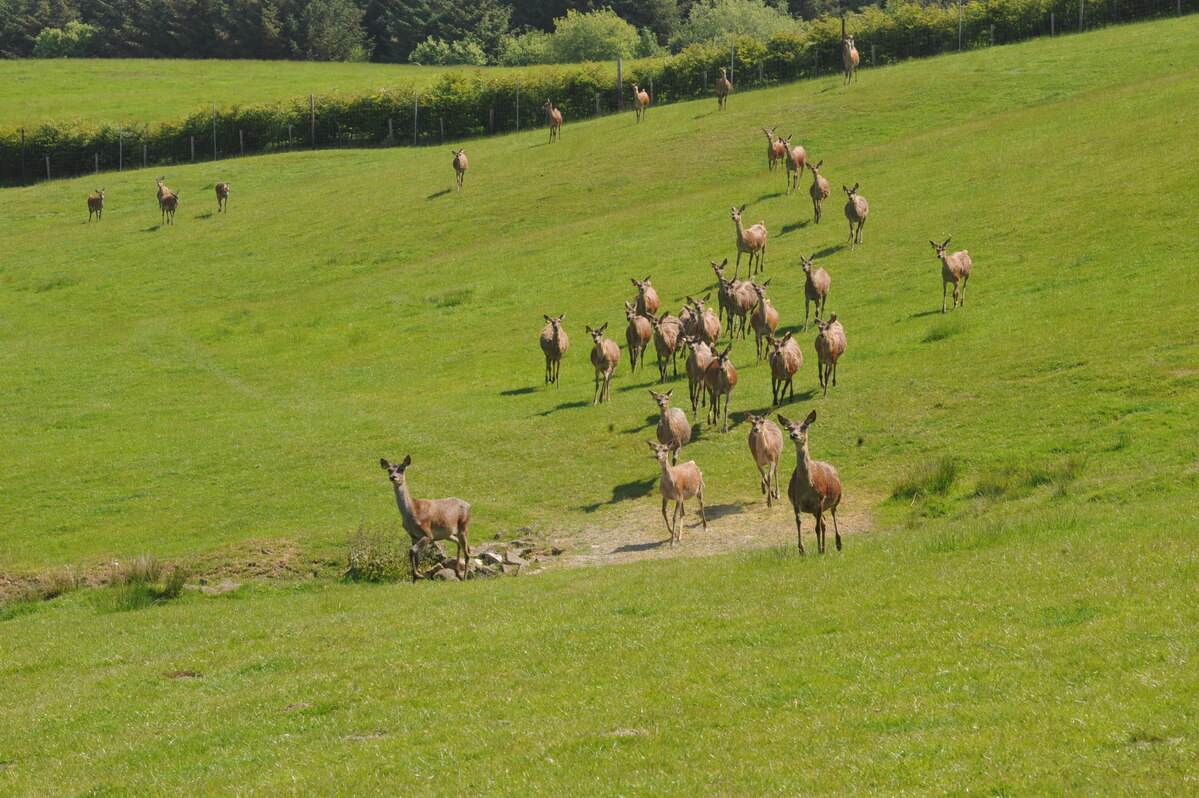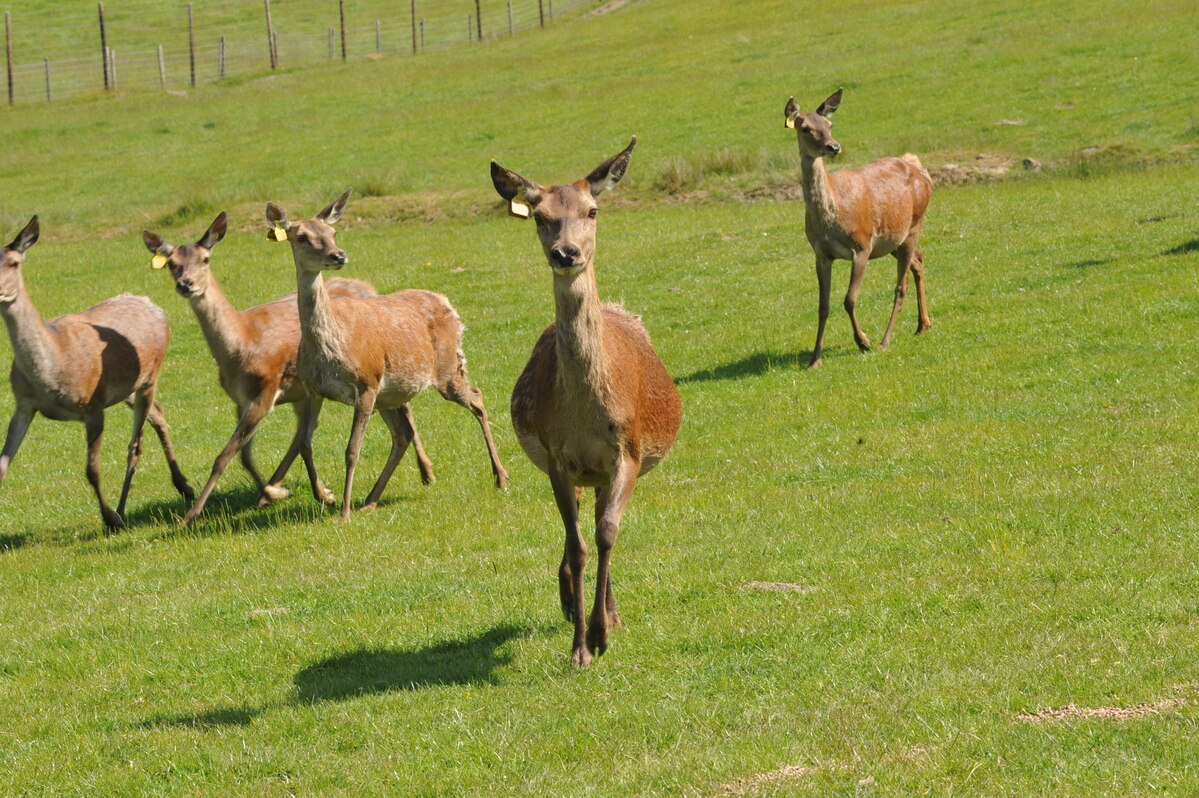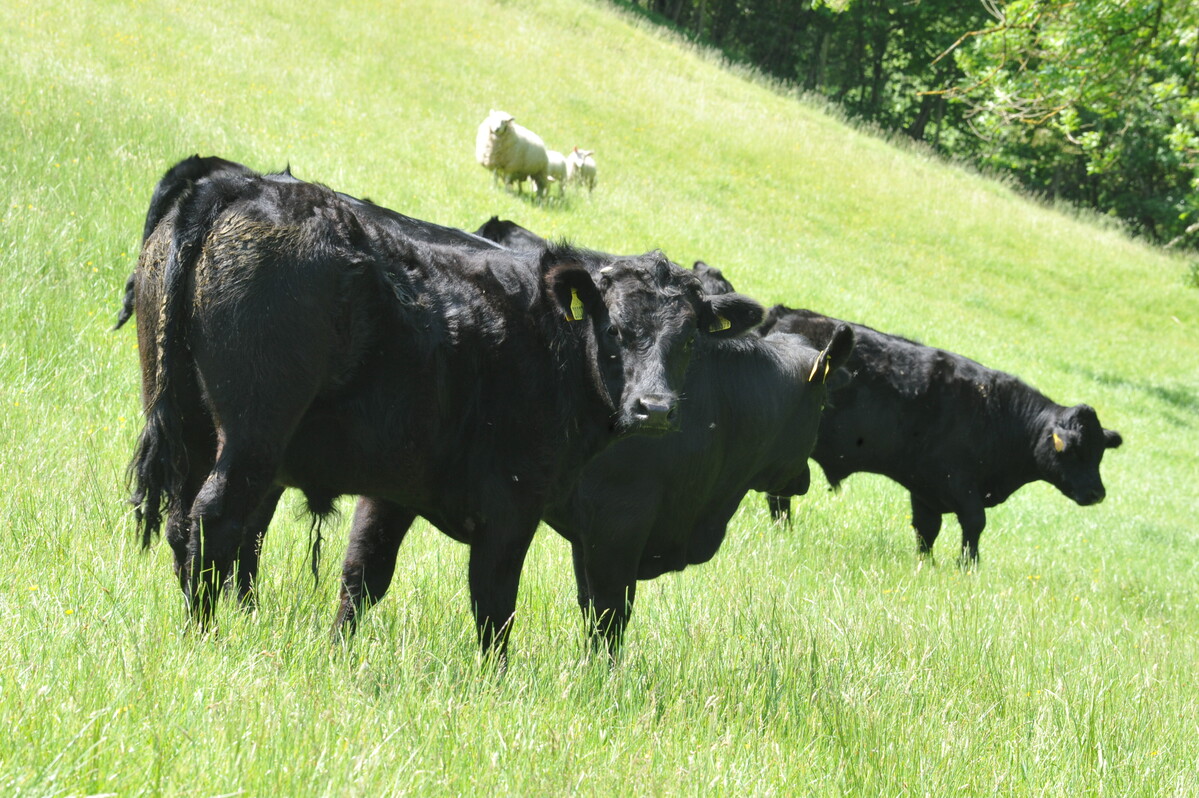If the newborn was a calf or a lamb produced by her family’s suckler cows or sheep she would intervene to take care of its health needs, dipping its navel perhaps, or seeing to the practicalities like checking its sex.
But the advice is to leave the mothers and their babies well alone, and it is only at weaning that Becca first meets the progeny close-up.
Breeding issues
As farmed deer are just a few generations removed from the wild, any issues with breeding have been dealt with by natural selection, she says.
“If a deer had an issue calving in the wild she wouldn’t survive so the genetics that may have caused that difficult calving have been bred out.”
Becca farms with her parents, Keith and Ali, in Powys, at 160ha (400 acre) Hendy Farm, near Hundred House.

Sights set elsewhere
It was never her intention to farm, she had in fact set her sights on becoming an art teacher, embarking on an art degree at the University of Wales Trinity Saint David, Carmarthen.
But just three weeks into that course she abandoned it. “We spent those weeks ‘responding’ to cardboard boxes, at that point I realised it just wasn’t for me!” she laughs.
Becca also missed the countryside and green fields. “I didn’t like being surrounded by concrete.”
She returned to Hendy, working as a nail technician while also helping out on the farm. It wasn’t long before she was further drawn into the day-to-day farm jobs, with both Becca and her parents recognising that there was an important role for her there.
Taken the farm for granted
“Until that point I had never realised that farming would be an option for me, I had taken the farm for granted but didn’t see the opportunities in it for me.
“I wanted to farm, and the opportunity was there. It has since made me appreciate how much harder it would have been to achieve that if my family weren’t farming.”
Keith and Ali were thrilled at her decision too. “The family has farmed at Hendy since 1904, it is wonderful to have that succession,” says Ali.
No obligation to farm
“Becca never felt any obligation to farm, we never put any pressure on her, and I think that really helped her to make a decision that was right for her.”
The three work well as a team, each having their own strengths and responsibilities.
For Becca, it is the deer that has given her a chance to make her mark.
It was not long after she returned to Hendy that Waitrose launched an advertising campaign encouraging farmers to diversify into deer, to boost its supply of venison.

Good fit for the business
“Dad joked that we should consider it but the more we thought about it the more we could see it would be a good fit for the business.
“We were already supplying Waitrose with beef and lamb, so it was the next step for us.”
It meant reducing the sheep flock by 200 ewes to create a dedicated 26ha (64 acre) grazing area for the deer but with a higher value end product, the economics favoured venison.
Three years on and the new enterprise is helping the Williamses make the best use of farm and labour resources as the key production stages in the three systems complement each other.
Research
After a great deal of research, which included visiting established commercial deer farms, they took the plunge in 2019, investing £100,000 in fencing and handling and buying 80 young hinds and two stags from UK deer farms.
These are run as two herds, with one stag to 40 hinds; the stags cost £2,000 a head compared to an average of £250 for the hind calves, but they should have a working life of 10 years.
The Williamses quickly realised that farming deer needed a different mindset to how they ran their sheep and cattle.
Changing mentality
“It was about changing our mentality as much as anything else,” says Becca.
“For example, we will work a dog behind the sheep when we are moving them but you can’t do that with deer. The deer will also always run along the fence line when you try to move them. It’s all those things that we had to get used to.”
And, although fields and sheds need to be secure to contain sheep and cattle, there are much greater requirements for deer.
Fencing needs to be at least two metres high and well maintained. If a deer escapes, it is unlikely that it will be seen again so there has to be absolute certainty that they won’t get out.
Deer easier to farm
But fencing and handling aside, for nearly every other management aspect Becca believes deer are easier to farm than sheep or cattle.
The hinds calve at grass in June and July. Calves stay with their mothers until weaning at five to six months old, after the rutting season, and they are housed in a cattle shed that has been fitted with netting.
Silage is fed in troughs during housing, while hinds and the stags are outwintered on hay and fed a minimal amount of concentrates to help with management.
Youngstock are turned out to grass at the beginning of April, just before the ewes are housed for lambing.
Sales
All sales are to Dovecote Park to supply Waitrose; it means a journey time of three hours and 40 minutes to Pontefract but the deer travel well.
The family had hoped to sell some of the meat direct to add value over and above the £6/kg deadweight they are paid by their processor, but it would mean hiring the abattoir specifically for that.
The regulations don’t allow for deer to be slaughtered in the same kill as other livestock so they would have to hire out the entire slaughterhouse, and pay for a vet to be present, which would not be financially viable for processing two or three deer.
Very few health issues
Deer have very few health issues – they don’t suffer from foot rot, fly strike or mastitis.
The only health interventions in the herds at Hendy are a copper bolus and worming if required, administered once a year pre-rutting, and a flukicide when the calves are weaned in December.
De-antlering is a job that needs to be done once a year, when the velvet has finished in August or September.
Elsewhere on the farm, the sheep flock is made up of 700 crossbred ewes and 180 ewe lambs, low maintenance sheep which Keith has bred with hybrid vigour in mind.
Performance recording
All breeding stock come from performance recorded flocks.
“Everything we buy has figures,” says Keith.
If a ewe has a health issue, her ear is notched and she is later culled. There have been multiple benefits from that strict approach, notably that there wasn’t a single prolapse during lambing this year.
Lambing is from 1 April, both indoors and outdoors. The flock scanned at 137% this year, down by 15% on an average year as a result of the exceptionally dry conditions in 2022.
Any lambs that can’t be finished off grass are sold as stores at Hereford market.

Cattle enterprise
The cattle herd consists of 26 polled Welsh Blacks, which calve from April.
Opting for polled genetics means less stress and a reduced labour requirement.
“It’s another reason to not have to handle the calves,” says Keith. “We don’t miss dehorning at this time of the year, when there are flies and maggots around.”
Work off the farm
Becca also works off the farm, wrapping wool, and for a grounds work business, helping to lay foundations for buildings and for projects like cycle paths.
It is a very physical job, mixing cement and carrying slabs, but one that Becca enjoys.
She is a very sociable person who thrives on the company of others and, as such, is involved in many off-farm activities, including as Secretary and Vice-Chairman of Edw Valley YFC and, with her older sister, Lauren, helps with the sheep section at the annual Hundred House Show.
NFU Cymru Next Generation Group
She is also a member of the NFU Cymru Next Generation Group. This has opened her eyes to the politics of farming, and she worries that governments don’t give farming and food production the gravitas they deserve.
“Farming should have a much higher priority in the work of government,” she said.
Becca and her parents share concerns about the new Sustainable Farming Scheme, the proposed 10% farm tree cover requirement in particular.
Sustainable Farming Scheme concerns
At just 2% existing tree cover, they have worked out that they would need to plant over 30 acres of Hendy with trees to meet that target and, with no waste ground they could concede to this, they are not willing to give up productive land for permanent tree cover.
“We have calculated that to make up for the loss of that land, Welsh Government would need to pay us £60,000 a year just to stand still, without us making money out of it,” says Keith.
“It just won’t be worthwhile us joining the scheme.”
As the third generation to farm at Hendy, what are Becca’s predictions for family farming there three generations hence if succession continues?
“I hope that we see a return to less food miles, to more direct sales and farm shops.
“It makes more sense for the environment to be selling straight from the farm instead of incurring food miles and all that packaging.”
